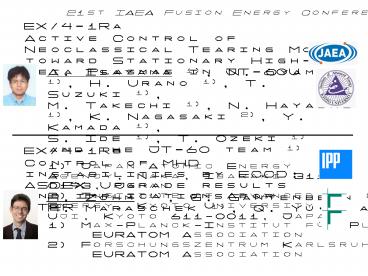Active Control of Neoclassical Tearing Modes - PowerPoint PPT Presentation
Title:
Active Control of Neoclassical Tearing Modes
Description:
Active Control of Neoclassical Tearing Modes. toward Stationary High-Beta Plasmas ... R.J. La Haye, R.J. Buttery, N. Hayashi, A. Isayama, M. Maraschek, ... – PowerPoint PPT presentation
Number of Views:62
Avg rating:3.0/5.0
Title: Active Control of Neoclassical Tearing Modes
1
21st IAEA Fusion Energy Conference, 16-21
October, 2006, Chengdu, China
EX/4-1Ra
Active Control of Neoclassical Tearing Modes
toward Stationary High-Beta Plasmas in JT-60U
A. Isayama 1), N. Oyama 1), H. Urano 1), T.
Suzuki 1), M. Takechi 1), N. Hayashi 1), K.
Nagasaki 2), Y. Kamada 1), S. Ide 1), T. Ozeki
1) and the JT-60 team 1) 1) Japan
Atomic Energy Agency, Naka, Ibaraki 311-0193,
Japan 2) Institute of Advanced Energy, Kyoto
University, Uji, Kyoto 611-0011, Japan
EX/4-1Rb
Control of MHD instabilities by ECCD ASDEX
Upgrade results and implications for ITER
H. Zohm 1), G. Gantenbein 2), F. Leuterer 1), A.
Manini 1), M. Maraschek 1), Q. Yu 1) and the
ASDEX Upgrade Team 1) Max-Planck-Institut für
Plasmaphysik, D-85748 Garching, Germany,
EURATOM Association 2) Forschungszentrum
Karlsruhe, IHM, D-76021 Karlsruhe, Germany,
EURATOM Association
2
Introduction
In tokamaks, many kinds MHD instabilities are
observed, and they can affect the plasma
performance. gt Control of MHD instabilities is a
key issue to obtain a high-performance
plasma MHD instabilities in the core regime
Neoclassical Tearing Modes (NTMs) - appear in a
high beta plasma - limit the achievable beta at
?Nlt?Nideal Sawtooth Oscillations - have
smaller effects on global parameters -
sometimes trigger an NTM Active control is
important Control tool Electron Cyclotron
Current Drive (ECCD) - highly localized current
drive - flexible ECCD location with steerable
mirror
3
Contents
This talk Control of NTM and sawteeth with ECCD
in ASDEX-U JT-60U
Sawtooth tailoring with ECCD Stabilization
of an m/n3/2 NTM by
modulated ECCD and by narrow
deposition Control of growth of a 3/2 NTM
by central co-ECCD
Stabilization of a 2/1 NTM TOPICS code
simulation of 2/1 NTM stabilization Summary
4
Sawtooth tailoring with narrow ECCD deposition
d ECCD width IECCD?exp-(r/d)2
d/a0.05
d/a0.02
- Change of sawtooth period by ECCD under otherwise
constant conditions - wide deposition ctr-ECCD ineffective (heating
effect has opposite sign) - narrow deposition IECCD/d2 enhanced w.r.t.
heating ctr-ECCD effective - note due to Bt ramp, complete stabilisation
could not be studied
5
NTM stabilisation with narrow deposition
Open symbols partial stabilisation Full
symbols complete stabilisation
ECCD current density peaking
- The NTM stabilisation efficiency increases with
narrow deposition - with wide deposition (ITER case), DC ECCD
results in partial stabilisation - modulation in phase with the island leads to
full stabilisation - note that this is done with same peak PECCD, but
half average PECCD
6
NTM stabilisation with modulated ECCD
15kHz modulation
X-point modulation
O-point modulation
Wide deposition (W/(2d)0.6)
Without modulation complete stabilisation was
not achieved Scan of the phase of ECCD w.r.t.
island O-point shows expected behaviour
- full stabilisation with O-point modulation
- only partial stabilisation with X-point
modulation
7
NTM stabilisation under ITER relevant conditions
Narrow Deposition W/(2d)1.2 (without modulation)
Fishbones
bN2.6
HH1.15
(3,2) NTM stabilisation in improved H-mode at
low q95 2.9 After stabilisation, good
improved H-mode conditions are recovered
8
Evolution of a 3/2 NTM has been suppressed by
central co-ECCD with IECCD/Ip0.1
Central co-ECCD can modify j(r) locally and
also enhance sawteeth gt These changes will also
affect the onset evolution of 3/2 NTM gt New
scheme for active control of 3/2 NTM
rEC0.1
rq1.50.4
9
Change in current profile and/or sawtooth
behavior is the candidate for NTM suppression.
For 4-unit ECCD, sawtooth amplitude ?inv
increase in time
Sawteeth and a small-amplitude 3/2 NTM can
coexist without large confinement degradation by
central co-ECCD
10
m/n2/1 NTM Larger confinement degradation or
disruption gt Active stabilization is essential
11
Further optimization of ECCD location has enabled
complete stabilization with JEC/JBS0.5
JEC/JBS measure of efficiency in NTM
stabilization Complete stabilization with small
JEC/JBS is desirable
Calculation
12
TOPICS simulation with modified Rutherford
equation well reproduces experimental results.
13
ASDEX Upgrade enhances its capabilities in this
area
Extension of ECRH system to multi-frequency, 10
s, 4 MW under way Feedback system for
deposition control is being set up sensors
ECE correlation ECE with same sightline as
ECRH mirror on-line q-profile reconstruction
actuators radial shift of plasma
position fast (50 ms) steering of poloidal
launch angle
14
Another presentation of NTM stabilization Results
from cross-machine comparison of NTM
stabilization and extrapolation to ITER
R.J. La Haye, R.J. Buttery, N. Hayashi, A.
Isayama, M. Maraschek, R. Prater, L. Urso, H.
Zohm, EX/P8-12 (Poster on Saturday morning)
2/1 NTM stabilization in ITER
JEC/JBS
DR/d
DR (cm)
Multi-machine database of NTM stabilization
has been made Prediction analysis on 2/1 NTM
stabilization in ITER shows that
JEC/JBS0.9 for perfect alignment JEC/JBS
gt1 for misaligned ECCD
15
Summary
Active control of NTM and sawteeth with ECCD has
been extensively performed in ASDEX-U JT-60U
Narrow ECCD deposition is very effective in
- sawtooth tailoring - 3/2 NTM
stabilization in an Improved H-mode
Effectiveness of modulated ECCD in 3/2 NTM
stabilization was demonstrated
Appropriate central co-ECCD can suppress the
growth of a 3/2 NTM A 2/1 NTM was
completely stabilized with JEC/JBS0.5 TOPICS
simulation well reproduces island evolution in
experiments
More detailed results of this talk will be
presented at the poster session on Saturday
morning!
16
Typical discharge of 2/1 NTM stabilization
Mode onset at t5.8s, ?N2 (?p1.2) Step
down of NB power with unidirectional NB at t7s
gt Mode rotation from t8s Unmodulated EC
wave injection from t9.5s. gt Complete
stabilization at t10.7s
17
Evolution of NTM is described by the modified
Rutherford equation































